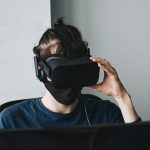Trainings and Evaluation
Employee training in workplaces, especially in terms of enhancing soft skills, has been elevated through the boom of Virtual reality in recent times. According to a study conducted by PWC, VR training has been proven to be 4 times faster and more effective than traditional forms of training like classroom and/or E learning. VR leaves employees feeling more connected and absorbent of the training material they ‘live through’ with the help of simulations crafted in the virtual space.
This leads to VR training being an effective investment for a business which leads to huge returns in the long term.
The question for most L&D leaders arises, how does one efficiently measure and analyze the outcomes of VR trainings on employees and the workplace overall. One of the biggest advantage’s VR offers in comparison to its counterparts is the capacity to monitor and evaluate feedback data from trainings. ‘Immersive Training data’, as we can call it enables L&D leaders to keep track of the learning outcomes of trainings on employees and accordingly render and enhance the training programs.
Kirkpatrick’s Model of Training Evaluation
Virtual reality training for elevating employee soft skills is on a high rise. So is the increasing value and awareness of data. Evaluation of training programs are as important as curating and implementing the training itself.
To make the best use of data at our disposal, we can look at the Kirkpatrick Model of Training evaluation in order to learn how to get the best out of training programs.
This model was introduced by Donald Kirkpatrick in the 1950s in order to evaluate training. It is included in his book called ‘Evaluating Training Programs, 1975’ and is known to be the most renowned method of evaluating training programs.
To break down the four stages of model in terms of VR training:
1. Reaction
The first stage of the model asks the question ‘What do the learners feel about the training’. As the initial and most integral part of the evaluation, the learner’s opinions, reactions and emotions in regard to their experience and engagement with the training content is very important to gain insight to what can be improved in the program. The feedback from this stage can be used to enhance and justify the value of the training program.
2. Learning
The second stage of the learning is most useful for L&D executives in order to determine whether the trainees have grasped the materials and skills provided by the training modules. In order to improve the program and get the best out of the employee’s potential, this stage involves skills evaluation. This helps fix chinks in the program if employees are unable to perform better than they did before. This stage can use competency tests to monitor the performance of trainees.
3. Behaviour
Behaviour changes and improvements in employees’ attitudes and performances are indicative of the effect of the training programs. This stage is subjective and not necessarily a reflection of the training program. It helps the L&D department showcase a clear rise in the improvement of the workplace performance, which can be indicated through KPI’s, to show the values grasped from this stage.
4. Results
This stage might be the most critical of the Kirkpatrick’s evaluation model, since it helps determine the impact and ROI of the training or the businesses growth. With huge investments going into training employees for companies, the results are the show for the investment. Increased soft skills, employee retention, increased sales, etc. are the results that can be quantified through this model which benefits the employees, L&D and training organisations all together in order to get most of the programs.
In the day and age of information being faster flowing and more easily available than ever, it is hard to grasp and retain essential knowledge for long term benefits. With VR training for employees to enhance soft skills, it is one of the biggest advantages to be able to measure the impacts of the training provided.
Just like a graded test, virtual reality gives its users the authority to measure and analyze the effects of the training conducted within the VR. Evaluation processes are an integral part to gain the most out of a program, to change and improve the program’s effectiveness along the way.
Written by Simran Singh
Similar articles to check out:







